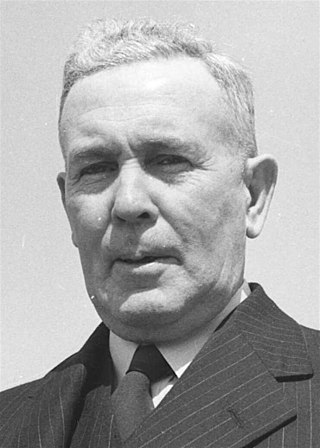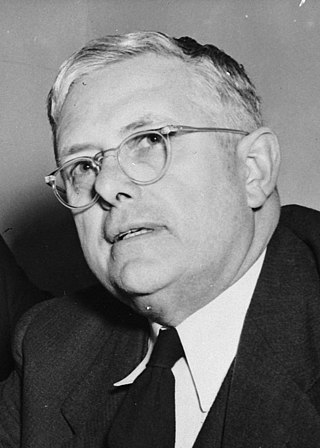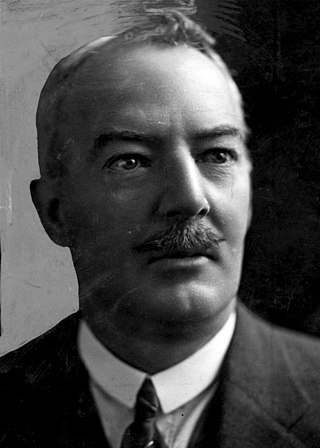The Frontbench of Ben Chifley was the federal Australian Labor Party frontbench from 13 July 1945 until Chifley's death on 13 June 1951. It was opposed by the Liberal-Country Coalition led by Robert Menzies.
Ben Chifley was appointed Prime Minister of Australia upon his election as leader of the Australian Labor Party on 12 July 1945 and his frontbench formed the Australian Government until Labor's defeat at the 1949 election. Chifley subsequently served as Leader of the Opposition until his death.
The following were members of the ALP Caucus Executive from 21 February 1950 to 20 June 1951: [1]

Joseph Benedict Chifley was an Australian politician who served as the 16th prime minister of Australia, from 1945 to 1949, holding office as the leader of the Australian Labor Party (ALP).

Francis Michael Forde was an Australian politician who served as the 15th prime minister of Australia from 6 to 13 July 1945, holding office as the deputy leader of the Australian Labor Party (ALP). He was prime minister in a caretaker capacity directly following the death of prime minister John Curtin, and is the shortest-serving prime minister in Australia's history.

Arthur Augustus Calwell was an Australian politician who served as the leader of the Labor Party from 1960 to 1967. He led the party through three federal elections, losing each one in turn.

Herbert Vere Evatt, was an Australian politician and judge. He served as a judge of the High Court of Australia from 1930 to 1940, Attorney-General and Minister for External Affairs from 1941 to 1949, and leader of the Australian Labor Party (ALP) and Leader of the Opposition from 1951 to 1960. Evatt is considered one of Australia's most prominent public intellectuals of the twentieth century.

Sir William John McKell was an Australian politician who served as the 12th Governor-General of Australia, in office from 1947 to 1953. He had previously been Premier of New South Wales from 1941 to 1947, as leader of the Labor Party.

The deputy prime minister of Australia is the deputy chief executive and the second highest ranking officer of the Australian Government. The office of deputy prime minister was officially created as a ministerial portfolio in 1968, although the title had been used informally for many years previously. The deputy prime minister is appointed by the governor-general on the advice of the prime minister. When Australia has a Labor government, the deputy leader of the parliamentary party holds the position of deputy prime minister. When Australia has a Coalition government, the Coalition Agreement mandates that all Coalition members support the leader of the Liberal Party becoming prime minister and mandates that the leader of the National Party be selected as deputy prime minister.

Edward John Ward was an Australian politician who represented the Australian Labor Party (ALP) in federal parliament for over 30 years. He was the member for East Sydney for all but six-and-a-half weeks from 1931 until his death in 1963. He served as a minister in the Curtin and Chifley governments from 1941 to 1949, and was also known for his role in the ALP split of 1931.

Edward James "Jack" Holloway was an Australian politician who served in the House of Representatives from 1929 to 1951, representing the Labor Party. He served as a government minister under James Scullin, John Curtin, Frank Forde, and Ben Chifley.

Edham Nurredin Husic, commonly known as Ed Husic, is an Australian politician serving as Minister for Industry and Science since 2022. Husic is a member of the Australian House of Representatives, elected to represent the seat of Chifley in western Sydney for the Australian Labor Party at the 2010 federal election. He is the first Muslim to be elected to federal parliament, as well as the first Muslim to be made a Minister in the Australian Government.

The Chifley government was the federal executive government of Australia led by Prime Minister Ben Chifley. It was made up of members of the Australian Labor Party in the Australian Parliament from 1945 to 1949.

The Curtin government was the federal executive government of Australia led by Prime Minister John Curtin. It was made up of members of the Australian Labor Party in the Australian Parliament from 1941 to 1945.
The history of the Australian Labor Party has its origins in the Labour parties founded in the 1890s in the Australian colonies prior to federation. Labor tradition ascribes the founding of Queensland Labour to a meeting of striking pastoral workers under a ghost gum tree in Barcaldine, Queensland in 1891. The Balmain, New South Wales branch of the party claims to be the oldest in Australia. Labour as a parliamentary party dates from 1891 in New South Wales and South Australia, 1893 in Queensland, and later in the other colonies.

A leadership election in the Australian Labor Party, then the opposition party in the Parliament of Australia, was held on 20 June 1951. It saw the election of Leader H. V. Evatt as leader following the death of sitting leader Ben Chifley.

The Australian Labor Party held a leadership election on 12 July 1945, following the death of Prime Minister John Curtin. Treasurer Ben Chifley won an absolute majority on the first ballot, defeating three other candidates: deputy leader and interim prime minister Frank Forde, navy minister Norman Makin, and attorney-general Herbert Evatt.

The Leader of the Liberal Party, also known as Leader of the Parliamentary Liberal Party, is the highest office within the Liberal Party of Australia and the Liberal–National Coalition. The position is currently, and has been since 30 May 2022, held by Peter Dutton, who represents the Division of Dickson in Queensland. Peter Dutton is the fifteenth leader of the Liberal Party. Dutton is also the first leader of the party to represent a Queensland electorate.
The Shadow Ministry of Gough Whitlam was the opposition Australian Labor Party frontbench of Australia from 8 February 1967 to 5 December 1972, opposing the Liberal-Country Coalition government.
The Frontbench of Arthur Calwell was the opposition Australian Labor Party frontbench of Australia from 7 March 1960 to 8 February 1967, opposing the Liberal-Country Coalition government.
The Frontbench of H. V. Evatt was the opposition Australian Labor Party frontbench of Australia from 20 June 1951 to 9 February 1960, opposing the Liberal-Country Coalition government led by Robert Menzies.
The Frontbench of John Curtin was the federal Australian Labor Party frontbench from 1 October 1935 until Curtin's death on 5 July 1945. It was opposed by the UAP-Country Coalition.